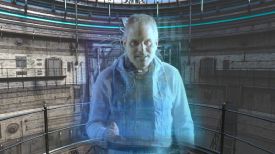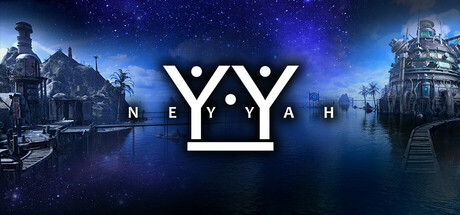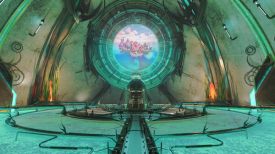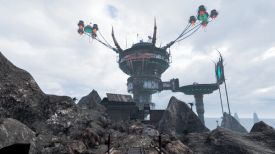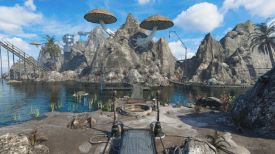|
By flotsam
Neyyah
Defy Reality Entertainment /
MicroProse
(a work in progress)
Games like Riven are my thing.
Solitary first person explorations in immersive worlds, vague objectives
needing to be picked apart, observation and logic front and centre and
inventories distinctly in the back seat - Riven itself is what nailed my
love of the adventure genre. So when a game proclaims its “in the style”
of Riven, I am immediately on board.
Which comes with potential
pitfalls. As I wrote about another such game many years ago “high
expectations can unfairly result in reduced impressions.” By which I
mean that if you associate yourself with Riven, I will hold you to a
high standard and judge you accordingly.
Whether that is fair or not, it
is what it is.
So let me say up-front, after 4
hours of playtime I am a very satisfied adventurer.
Borrowing from the Steam page,
Neyyah is set within a collection of remote almost abandoned islands,
separated by a series of complex portal machinery and laced with the
fingerprints of two intriguing cultures. You have been sent there by
Vamir, on a matter of urgency. A wrong needs righting, one that will
require you to traverse the islands, linking the portals, unlocking
contraptions and deciphering clues as you go.
You might have gathered by my
playtime and the ‘work in progress’ heads-up that I haven’t yet finished
the game. I felt compelled though to put pen to paper, given the
impending release, and am confident that I can safely tell you more than
I would in a first look. I will come back and update things when I do in
fact finish.
You will get a distinctive
(original) Riven vibe from the very get go, including the node-to-node
progression. You can turn left or right, and perhaps look up or down,
and helpfully you will also be told whether turning from any node will
change your point-of-view by 90 or 180 degrees, improving the efficiency
of exploring your environment. Whilst I prefer the go anywhere freedom
of the remastered Riven, this form of exploration still provides a more
than satisfactory explorative environment.
The visuals help. The
pre-rendered screens provide an artistic opportunity when it comes to
detail, and while the colour is a tad muted, the islands themselves and
their structures are enticing places, drawing you on. Lighting is a
treat, and whilst each screen is largely static, the ambient sound and
things like the shimmer of the sea help the sense of realism. Various
environmental animations (doors opening, levers moving, etc.) add
another element, and I recently unlocked a vary Riven-ish ride to
somewhere else.
Sure I would love a more dynamic
world, but I didn’t feel a bit disappointed.
The curser will indicate when
something can be done (e.g., zoom in, pick up, use an item etc).
Puzzling has to date been to gather information and use it to solve
codes, or restore or redirect power, to open up more areas and do the
same again. Some inventory items have been involved, but as an adjunct
to the logic.
How you progress through the
game is something relatively within your control. To start with, three
different Journey Modes are available, which you can switch between as
you go, and which provide a lesser or more degree of feedback and
(possible) assistance. The Guided by Ancients mode provides the most
feedback, providing notifications of new maps and locations, tutorials
for controls and features, and Travellers Guide notifications (more of
them a bit later). The two other Modes provide lesser and then no
notifications, although you can tweak certain aspects should you want
to.
From within the game you can
also access various Journey Tools. The Traveller’s Guide records various
observations, often complete with image, and perhaps pushing you in the
right next direction (and those notifications I mentioned before will
tell you something has been added). The Main Goals describes the things
you need to do in order to finish the game, and the Character
Interaction allows you to replay interactions with the other characters
you might encounter. Each is accessed via specific keyboard shortcuts,
or the Escape key brings up a ribbon top of screen where you can point
and click the relevant tile to access your desired tool.
That same ribbon also contains
tiles for your inventory, journals you gather, and maps that build as
you go, as well as for the more rudimentary game mechanics (e.g., save,
options, quit). There is also a Payetta Case tile, which contains
culturally specific items and one which is still greyed out which
remains to be revealed.
The Options tile warrants
further mention. As well as the more usual options (e.g., subtitles on
or off, adjust music volume) you can enable a fast travel mode, which
will enable you to skip intervening nodes and jump to an endpoint,
(although you can progress node to node should you prefer) and also turn
on colour blind mode, which will tell you the colour you are looking at
(which can be important in certain puzzles). Having fiddled, I turned
both on using the former sparingly and the latter when a colour puzzle
presented itself.
Another thing worth mentioning
is that notwithstanding the Travellers Guide, you should still take
notes. Things I wanted to know weren’t always captured by the Guide, so
your pen and paper is still required. Indeed, I intend to turn off all
notifications for the next little while and to manually record anything
I think I might need.
I Googled a bit and found that
this has been about seven years in the making, and reflects the sunny
and warm environments of the Australian based developers. Both those
things are incidental plusses.
I have currently accessed a
secret lab, which took some getting to and which contains a fair degree
of information. I am drawing breath, reflecting on what and where I am
at and considering where to next. My Riven gene has been feted by what
has come before, and I look forward to what is to come.
Update
I am about 18 hours of playtime
in (give or take the need to access a walkthrough and leaving the game
running to attend to real life events) and am relatively close to the
end (I think) but also thoroughly stuck.
I like being stuck. Its kind of
the point; get stuck, review what you know, revisit locations, and
winkle the stuckness out.
That said, Neyyah is a big
place, full of different geographic locations and a plethora of spaces
within them. It also contains a lot of information, in the journals you
find, the notes you read, the systems you access, and the video messages
you might uncover, not to mention the clues you might discover in the
environment. Which makes for plenty of open adventuring and intricate
puzzling.
It’s a big plus, but also a
potential roadblock.
For instance, when a door won’t
unlock for some reason, what that reason is might be largely
unfathomable. This happened; I came across a door, thought I done
everything necessary, but it wouldn’t open. Why it wouldn’t open I had
no idea, and no amount of revisiting the information I had uncovered
suggested a way forward. It turned out I had missed turning a lever in
one spot earlier on. My bad for not exploring properly, but unless I
missed a clue, there is no way I would have thought to go back to that
location to look for a lever, which resulted in a degree of aimless
wandering in the hope of finding something, until I gave up and accessed
a walkthrough.
Which in itself is not
straightforward, given the openness of how you might have progressed in
the game.
Perhaps there was a clue. And
yes, I should have searched more carefully. But there were other such
times when what to do next or how to progress would have benefited from
being a tad more obvious.
Which doesn’t mean I want paint
by numbers, and I love being dropped into a realm such as this that
requires unravelling, but sometimes a little bit less can be a lot more.
There is so much information here to go back over, and so many places to
revisit, that it can feel overwhelming at times.
A bit like the one I am
currently involved in.
Nonetheless I remain a very big
fan, and would readily recommend Neyyah to anyone who likes these sorts
of games. It is challenging and engrossing, frustrating and fascinating.
It looks a treat, sounds quite wonderful, and warrants just hanging
about (nature abounds if you look carefully). It’s elaborate in almost
every respect – the puzzles, the story and the environment – and I look
forward to wrestling my way out of my current impasse.
As I indicated earlier, the game
also collects a heap of information as you go, helpfully collating it by
location. I would have liked a search function, and I still recommend
taking your own notes, but it helps keep track of many relevant bits and
pieces.
I did hit a bug, which the maker
helped me overcome. Kudos to him. He is responsive at the Steam
discussions, and will patch and/or solve issues brought to his
attention. If only every maker was as attentive.
I will give you my final
observations when I finish.
I played on:
OS:
Windows 11, 64 Bit
Processor: Intel i7-9700K 3.7GHz
RAM:
Corsair Dominator Platinum RGB DDR4 32GB
Video
card: AMD Radeon RX 580 8192NB
GameBoomers Review Guidelines
August 2025
design copyright© 2025
GameBoomers
Group
 GB
Reviews Index GB
Reviews Index |

